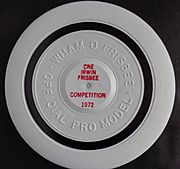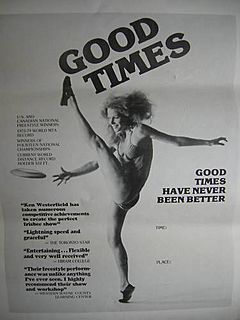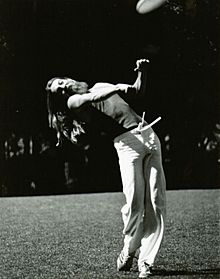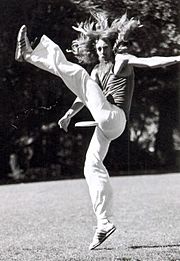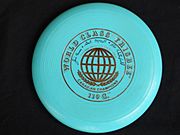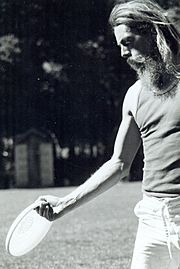Ken Westerfield facts for kids
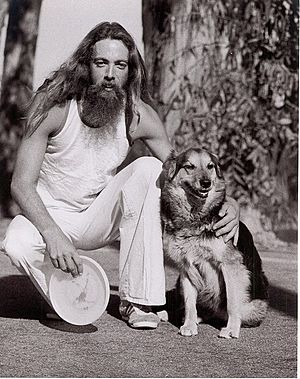
Westerfield in Santa Cruz, California, 1970s
|
|
| Personal information | |
|---|---|
| Full name | Kenneth Ray Westerfield |
| Nickname(s) | "Legend" |
| Born | Detroit, Michigan, U.S. |
| Years active | 1963–1988 |
| Sport | |
| Country | Canada and the United States |
| Sport | Disc sports (Frisbee) |
| Event(s) | Freestyle, ultimate, disc golf, double disc court, distance and overall events (TRC, MTA, and accuracy) |
Kenneth Ray Westerfield is an American pioneer in Frisbee disc sports. He achieved many great things in the 1970s. He is in the Hall of Fame for freestyle, ultimate, and disc golf. People also voted him "Top Men's Player" for the years 1970-1975.
Westerfield helped organize many tournaments. He set world records and won awards in every disc sport. He was a co-director for big events like the Canadian Open Frisbee Championships. He also started the first ultimate league in Canada, called the Toronto Ultimate Club, in 1979. Ken was one of the first freestyle players from the 1960s. He used his skills in many company-sponsored Frisbee shows across the U.S. and Canada.
Contents
- Early Life and Sports Beginnings
- Discovering Frisbee and Disc Sports
- The Start of Flying Disc Sports and Championships
- Competitive Years in Disc Sports (1974-1979)
- Disc Golf Achievements
- Ultimate Frisbee Contributions
- Disc Sports Legacy
- Awards, Achievements, and Timeline
- See also
- Images for kids
- Books about Frisbee and Disc Sports
Early Life and Sports Beginnings
Ken Westerfield was born in Detroit, Michigan. His mother, Margaret, worked as an administrator for schools. His father, Gene, was a refrigeration contractor. Ken grew up in a close family with his younger sister, Kathy.
Both of Ken's parents were athletic. His father taught him many different sports. Ken's grandfather, Cleo Conn Westerfield, played baseball in the 1920s. This helped spark Ken's early interest in sports. Besides disc sports, he enjoyed baseball, hockey, motorcycles, golf, and basketball. He played in several city leagues for these sports.
Discovering Frisbee and Disc Sports
In 1960, when Ken Westerfield was thirteen, he became best friends with Jim Kenner. Jim later started the company Discraft. They began playing Frisbee during high school. Every day, they tried new ways to throw and catch the Frisbee. This creative play was later called "freestyle."
Back then, Frisbee was just a toy for fun. There were no professional players or tournaments. Ken and Jim didn't like traditional sports. So, they developed amazing Frisbee skills that no one had seen before.
After high school in 1965, Ken and Jim spent summers at beaches. They also showed off their Frisbee skills at music festivals. They even took their Frisbees to Woodstock, a famous music event in New York. They would throw the Frisbee over the crowd, just out of reach. People would try to grab it as it flew by.
In 1970, Ken and Jim moved to Toronto, Canada. They practiced Frisbee freestyle and object disc golf daily in Queen's Park. The next year, they hitchhiked across Canada with just a little money and a Frisbee. They performed street shows in cities and at big events like Klondike Days in Edmonton.
After their tour, they lived in Vancouver for the summer. They performed nightly Frisbee shows in the Gastown area. They bounced the disc off buildings and threw it around statues. One night, they were performing during a demonstration that turned into the famous Gastown Riots.
In late 1971, Ken and Jim needed money to return to Toronto. They started collecting donations like street musicians, and it worked! Back in Toronto, they lived in Rochdale College. They performed Frisbee shows on Yonge Street Mall. Thousands of people watched their amazing skills.
They wanted to make their shows more professional. They approached Irwin Toy, a Frisbee distributor in Canada. They showed Irwin Toy how their performances could promote Frisbees. In 1972, Irwin Toy hired them. Ken Westerfield and Jim Kenner became the world's first full-time professional touring Frisbee players.
The Start of Flying Disc Sports and Championships
Disc sports really began in the 1970s with several important tournaments. Before these events, Frisbees were just toys. But Ken Westerfield and Jim Kenner were already seen as serious athletes. They worked with Andrew Davidson and Jeff Otis to create the Canadian Open Frisbee Championships (1972-1985) in Toronto.
This competition started with events like Guts and distance throwing. Later, it added disc golf, freestyle, ultimate, and other individual events. In 1975, the tournament moved to Toronto Islands. Westerfield and Kenner also started the Vancouver Open Frisbee Championships (1974-1977). Many of today's disc sport techniques and rules come from these early pioneers. These championships introduced Frisbee as a real sport, including the first competitive freestyle events.
Freestyle is a competition where two or three players perform a routine to music. They use creative throwing and catching techniques. Judges score the routine based on how difficult it is, how well they do it, and how they present it. Before 1975, freestyle was fast-paced. It involved many different throws and stylish catches. It was often compared to martial arts or dance.
In 1973, Ken and Jim tried to add a freestyle competition to the 2nd Canadian Open. But there weren't enough players, so it was canceled. The next year, new freestyle players from the U.S. came to Toronto. In 1974, at the 3rd Canadian Open, Westerfield and Kenner introduced the freestyle event again, and they won it!
They became the world's first Freestyle Frisbee Champions. That same year, they organized another freestyle competition at their Vancouver Open. A year later, other big tournaments like the American Flying Disc Open and the World Frisbee Championships adopted their freestyle format. Today, freestyle is a top event in disc tournaments worldwide. Ken and Jim received an award for "Top Freestyle Routine" for their 1974 Canadian Open performance. They were also inducted into the FPA Freestyle Disc Hall of Fame.
In 1974, Westerfield and Kenner suggested performing Frisbee shows at basketball halftimes in Canadian universities. They called themselves the Molson Frisbee Team. Molson Breweries liked the idea. The next year, Molson's increased their payment and used their show to launch a new beer.
In 1975, with Molson's help, the Canadian Open Frisbee Championships moved to Toronto Islands. Molson's continued to sponsor their shows and events for years. This helped Ken and Jim promote their new sport everywhere.
Competitive Years in Disc Sports (1974-1979)
Frisbee tournaments started attracting many skilled players. What was once a popular toy became a serious competitive sport. Ken Westerfield was 27 in 1974, the first year of freestyle and overall competitions. He competed for five years and won in every disc sport.
Ken loved that playing Frisbee didn't have to be competitive to be challenging. He helped create and won the first freestyle competition. Between 1976 and 1978, he won six U.S. national freestyle titles. He also reached the finals in fifteen other freestyle events. When disc golf, ultimate, and other disc sports were introduced, Ken quickly became good at them. Many of his freestyle skills helped him in these new sports. Ken competed for Canada in U.S. and World competitions because Toronto was his home.
In 1975, at the Canadian Open, Ken set a world record for "maximum time aloft" (MTA). He threw a Frisbee that stayed in the air for 15 seconds. This beat the old record of 11 seconds. Also in 1975, Ken invented a new freestyle move called the "body-roll." This is where you roll the disc across your outstretched arms and chest, or back. He showed this move at a tournament in New York. Today, body-rolls are a key part of almost every freestyle routine.
In 1974, Wham-O sponsored the first World Frisbee Championships (WFC). Tournaments across the U.S. and Canada helped players qualify for the WFC at the Rose Bowl in Pasadena, California. Ken won many freestyle and individual events. He was named "Best Player of the Decade" for 1970-1975.
At a tournament in Dallas, Texas, Ken joined the "400 club." He threw a Frisbee 378 feet using a sidearm throw. Only two players had officially thrown a 119-gram Frisbee over 400 feet in competition.
In 1978, in Boulder, Colorado, Ken threw a 119-gram Frisbee 552 feet during a demonstration. He used his special sidearm throw. This beat the official world distance record of 412 feet. Kevin Givens, a World Freestyle Champion, remembered it as "the most incredible throw I'd ever seen."
Ken's 552-foot throw was the longest sidearm throw until 2014. Even with new, heavier discs and windy conditions, Ken's throw is still the longest measured distance for a Wham-O brand Frisbee disc.
In 1977, Jim Kenner started a disc manufacturing company called Discraft in London, Ontario. Meanwhile, Ken Westerfield went to Santa Cruz, California. He worked with Tom Schot to organize Frisbee events there. Ken also played in one of the first ultimate leagues in the U.S. He created the Good Times Professional Frisbee Show. This show featured freestyle champions like Mary Kathron. Ken and his team performed for big companies like Labatt Brewing Company and Air Canada.
Disc Golf Achievements
As of 2025, there are over 7000 disc golf courses. Before 1975, there were only a few disc golf courses. These early courses used objects like trees or poles as "holes." Rochester, New York, Berkeley, California, and Toronto, Ontario, had the first designed courses.
In Canada, starting in 1970, Ken Westerfield and Jim Kenner played Frisbee golf daily. They designed an 18-hole course in Queen's Park in Toronto. They also added disc golf to their Canadian Open and Vancouver Open tournaments. These were Canada's first disc golf tournaments. They started with object holes and later used special disc pole holes.
Ken Westerfield stopped competing in disc golf in 1979. He continued to promote disc sports in Canada, especially ultimate. In 1987, the Canadian Disc Golf Association asked Ken to organize the PDGA World Disc Golf Championships in Toronto. Ken and Bob Blakely successfully organized the event. It was the only time this championship was held outside the United States. For his work, Ken became an honorary PDGA Member. He retired from disc sports in 1987. Ken Westerfield was inducted into the World Disc Golf Hall of Fame.
Ultimate Frisbee Contributions
Ultimate is a team sport played with a flying disc on a rectangular field. Teams pass the disc down the field. Points are scored when a player catches the disc in the opposing team's end zone. The other team tries to stop them.
Ultimate has a special rule called the Spirit of the Game. This means that how a player acts is as important as winning. Ken Westerfield brought this spirit to all his disc sports. This idea wasn't invented by one person. It was just how these early athletes competed. The "Spirit of the Game" is still a big part of disc sports today. It was added to the ultimate rules in 1978.
Starting in 1975, the Canadian Open Frisbee Championships introduced ultimate to Canadians. Ken played in these early exhibition games. He continued to play ultimate through the 1970s. He played on Santa Cruz's first ultimate team, called Good Times.
In 1979, Ken Westerfield stopped competing in national freestyle and disc golf. He focused on organizing local disc events in Toronto. Ken loved ultimate. With help from Bob Blakely and Chris Lowcock, he started the Toronto Ultimate League. They began with weekly games at Kew Beach. Then, teams formed from different parts of Toronto.
Ken used Bob Blakely's office to make a weekly newsletter. It shared game results and league standings. The Toronto Ultimate League grew and became the Toronto Ultimate Club (TUC). Today, TUC has over 3300 members and more than 250 teams. It is the first ultimate league in Canada and one of the oldest in the world.
In 1987, Ken's team, Darkside, won Canada's first national ultimate championships. In the 1980s, Ken was known for his expert handling skills. He also had a strong sidearm throw, called a "huck" or "pull." His pulls often landed deep in the opposing team's end zone. This gave his team plenty of time to set up their defense.
In 2013, the Toronto Ultimate Club helped create Canada's first semi-professional ultimate team, the Toronto Rush. They had a perfect season, winning all 18 games, and won the AUDL Championships.
In 2010, Ken Westerfield was inducted into the first class of the Toronto Ultimate Club Hall of Fame. In 2011, he was also inducted into the first class of the Ultimate Canada Hall of Fame.
Disc Sports Legacy
Disc sports grew partly from an unexpected beginning. Ken Westerfield and others started playing Frisbee as a way to be different from traditional sports. But this eventually led them to work with Frisbee manufacturers to sell more discs. As a result, disc sports have become one of the fastest-growing sports today.
Ken Westerfield is known for his athletic achievements. He was one of the best players of his time. He is also recognized as a pioneer, innovator, and organizer for all disc sports. He performed in many shows as one of the first professional touring Frisbee players. He helped start some of the first disc sport competitions and organizations in Canada and the U.S. Many of these are still active today.
Freestyle and freestyle competitions are played worldwide. Ultimate is also very popular, with over 1.48 million regular players in Canada and the U.S. alone. Disc golf is played on over 7000 courses in about 40 countries. It has 500,000 regular players.
What started as Ken Westerfield's daily pastime in the 1960s became his amazing legacy in disc sports. It even became a recognized sport using the flying disc.
After retiring from playing and promoting disc sports in 1988, Ken started several businesses. He imported exotic plants and ran a rock and roll bar. He also owned a motorcycle shop. Today, Ken is mostly retired. He spends his time in Bisbee, Arizona, a small town near the U.S. Mexican border. He loves helping animals and volunteers with animal rescue groups.
Awards, Achievements, and Timeline
- 1960 – Westerfield and Jim Kenner become friends.
- 1963–1965 – Westerfield and Kenner start their free-form Frisbee play during high school summers.
- 1965–1969 – They perform Frisbee freestyle for crowds at rock concerts and music festivals, including Woodstock.
- 1970 – Westerfield and Kenner move to Toronto, Canada. They play Frisbee freestyle and disc golf daily in Queen's Park. This was one of the earliest designed object disc golf courses.
- 1971 – They hitchhiked across Canada, performing unsponsored Frisbee street shows. They spent a summer doing shows in Gastown, Vancouver.
- 1971 – They were involved in the Vancouver Gastown Riots while performing Frisbee shows.
- 1971–1974 – Living in Rochdale College, they performed nightly Frisbee shows on the Yonge Street Mall in Toronto.
- 1972–1976 – As Canadian Frisbee Champions, Irwin Toy hired Westerfield and Kenner to perform shows across Canada.
- 1972–1985 – They co-produced the Canadian Open Frisbee Championships in Toronto. This event introduced disc sports to Canada.
- 1973 – They planned the first freestyle competition at the 2nd Canadian Open, but it was canceled due to few competitors.
- 1974 – Westerfield and Kenner introduce and win the first freestyle competition at the Canadian Open.
- 1974 – They receive "Best Freestyle Routine" at The Decade Awards for their 1974 Canadian Open performance.
- 1974–1979 – They were sponsored by Adidas Canada for clothing.
- 1974–1977 – They were the Molson Frisbee Team, performing shows at special events and universities.
- 1974–1977 – Westerfield and Kenner produced Western Canada's first disc sports competitions, the Vancouver Open.
- 1975 – He set a World MTA Record of 15 seconds at the Canadian Open.
- 1975 – He was voted Best Men's Player for 1970-1975.
- 1975 – The Canadian Open introduces ultimate. Westerfield played in these early exhibition games.
- 1975 – He introduced the "body-roll" freestyle move at the American Flying Disc Open.
- 1975–1978 – His signature was on the Canadian World Class Frisbee.
- 1976 – He presented the first disc golf tournaments in Canada, first with objects, then with disc pole holes.
- 1976 – He appeared on the Peter Gzowski television show and performed at a Greenpeace rally.
- 1976–1978 – He won 15 first-place titles in North American Series (NAS) National Frisbee Championships. This included 6 U.S. national freestyle titles.
- 1977 – Westerfield went to Santa Cruz, California, to help organize Frisbee events. Kenner started Discraft.
- 1977–1979 – Westerfield played ultimate in the Northern California Ultimate Frisbee League.
- 1977 – He designed and manufactured a flying disc with Tom Schot.
- 1977–1978 – He was part of the Orange Crush Frisbee Team, touring Canada with Mary Kathron.
- 1978–1979 – He was part of the Air Canada Frisbee Team, performing across Canada.
- 1978 – In Dallas, Texas, he joined the "400 Club" with a 378-foot sidearm throw.
- 1978 – In Boulder, Colorado, he threw a 119-gram Frisbee 552 feet. This is still the longest distance for a Wham-O Frisbee disc.
- 1978 – He co-produced the Santa Cruz Flying Disc Classic.
- 1978–1982 – He performed with the Good Times Professional Frisbee Show across Canada and the U.S.
- 1979 – He was featured in a Wham-O film about the 1979 World Frisbee Golf Championship.
- 1979–1980 – He performed freestyle shows with the Lee Jeans Frisbee Team.
- 1979 – He started the Toronto Ultimate League (Club), the first ultimate league in Canada.
- 1979 – He retired from competing in national freestyle and overall competitions. He continued to organize local events and play ultimate.
- 1983–1985 – He performed with the Labatt's Schooner Frisbee Team.
- 1985 – He co-produced the World Labatt's Guts Championships in Toronto.
- 1987 – He produced the World Disc Golf Championships (PDGA) in Toronto. This was the only time it was held outside the U.S.
- 1987 – He won the National Champion title with his team Darkside at the Canadian Ultimate Championships (CUC) in Ottawa, Ontario.
- 1988 – At age 40, he retired from playing ultimate and organizing disc sports.
- 2010 – He was inducted into the first class of the Toronto Ultimate Club Hall of Fame.
- 2011 – He was inducted into the first class of the Ultimate Canada Hall of Fame.
- 2012 – He was featured in a film documentary called The Invisible String.
- 2013 – He was inducted into the World Disc Golf Hall of Fame.
- 2013 – The Toronto Ultimate Club helped launch Canada's first semi-professional ultimate team, the Toronto Rush.
- 2014 – His first ultimate team, Beaches, was inducted into the Toronto Ultimate Club Hall of Fame.
- 2016 – He was inducted into the first Pioneer Class of the FPA Freestyle Disc Hall of Fame.
See also
Images for kids
Books about Frisbee and Disc Sports
- Danna, Mark, and Poynter, Dan; Frisbee Players' Handbook, Parachuting Publications, Santa Barbara, California (1978); ISBN: 0-915516-19-5
- Horowitz, Judy, and Bloom, Billy; Frisbee: More Than A Game of Catch, Leisure Press, Champaign, Illinois (1984); ISBN: 978-0-88011-105-8
- Leonardo, Tony and Zagoria, Adam co-authored "Ultimate: The First Four Decades," publ. by Ultimate History, Inc., 2005, ISBN: 0-9764496-0-9
- Morrison, Fred & Kennedy, Phil; Flat Flip Flies Straight! True Origins of the Frisbee, Wormhole Publishers, Wethersfield, CT (January 2006); ISBN: 0-9774517-4-7
- Norton, Gary; The Official Frisbee Handbook, Bantam Books, Toronto/New York/London (July 1972); no ISBN
- Palmeri, Jim & Kennedy, Phil; A Chain of Events, The Origin & Evolution of Disc Golf Paperback, Unabridged (2015); ISBN: 978-0-9774517-0-8
- Stancil, E. D., and Johnson, M. D.; Frisbee, A Practitioner's Manual, and Definitive Treatise, Workman Publishing Company, New York (July 1975); ISBN: 978-0-911104-53-0
- Tips, Charles; Frisbee by the Masters, Celestial Arts, Millbrae, California (March 1977); ISBN: 978-0-89087-142-3
- Tips, Charles, and Roddick, Dan; Frisbee Sports & Games, Celestial Arts, Millbrae, California (March 1979); ISBN: 978-0-89087-233-8



